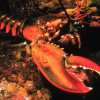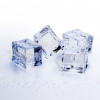Colourful dino feathers
Interview with
'Fluffy feathers' is probably not what springs to mind when thinking about dinosaurs; but based on fossil records, at least some dinosaurs are thought to have had plumage, and most likely colourful plumage too. Now scientists think we can add another prehistoric creature to the feathered list: pterosaurs. A specimen of one of these flying reptiles shows feather-like sprays issuing from its head, and, by looking at very high magnification, the University of Cork’s Maria McNamara has been able to pick out structures called melanosomes, that would have held the melanin pigment that gives skin and the feathers of modern birds their colour schemes. She took Julia Ravey through the findings…
Maria - Pterosaurs were flying reptiles. They ruled the air at the same time that dinosaurs were roaming the land, and they had long leathery wings, short legs, and some had enormous head-crests.
Julia - And when I think of flying, what comes to my mind is feathers. So did these reptiles have feathers?
Maria - That is the million dollar question. For many years we've known that pterosaurs had an outer coat of some kind of fluffy stuff. Then we rocked the boat a little bit, a few years ago when we reported that we had found branched feathers in two juvenile pterosaurs from China. The style of branching in those feathers was not quite like that of modern birds, the feathers were actually branched in little tufts, but now we found a pterosaur from a different group. And the style of branching in this pterosaur head-crest is much more like the style of branching we see in modern birds because the branches are successive. You know, they're the whole way along the feather shaft. So feathery pterosaurs are a thing.
Julia - Did you find out anything else about the properties of this feathery coat?
Maria - Where things got really exciting was when we put the feather samples under the electron microscope. And we found that they preserve little granules of the pigment melanin. What was very unexpected was the fact that the melanosomes had different shapes in different feathers. So the simple unbranched feathers have real sausage shaped melanosomes, and the branch feathers have shorter egg-like melanosomes. This is really exciting because modern birds do the same thing and they do it to make different colours.
Julia - How does the shape of these melanosomes impact feather colour?
Maria - Depending on the melanosome shape, you can produce, for instance, orange redish, ginger colours. They are produced by ball shaped melanosomes, whereas blacks and dark browns are produced by sausage shaped melanosomes. This very strongly suggests that those different feathers had different colours.
Julia - If these animals had coloured feathers, what colours do we think these might have been?
Maria - It's difficult to give a precise hue because our current models, which we're using to infer colour aren't as accurate as we'd like. Especially when it comes to trying to figure out how other pigments might influence the colour. Just finding melanosomes doesn't necessarily mean that your feathers were black or brown, but that long bone that sticks out from the back of the pterosaur head, would've had these black unbranched feathers near the head, and then out near the tip it would've had these paler branched feathers. That's our best guess for now.
Julia - If pterosaurs had these, you know, coloured pigmented feathers, what do we think they might have been used for?
Maria - You know, to answer that question, we really would need to get a good handle on the precise colour and on the colour pattern. But because we only have the head, we can't really tell what colour patterns they had. It just tells us that the importance of visual signaling of sending signals to other animals, maybe about your fitness or maybe to attract mates, or maybe for camouflage, how important this is for survival. I guess, you know, we just have to find some pterosaur specimens with feathers distributed over the whole body and start looking at the patterning.
- Previous The CERN makeover
- Next The Inca and antidepressants










Comments
Add a comment